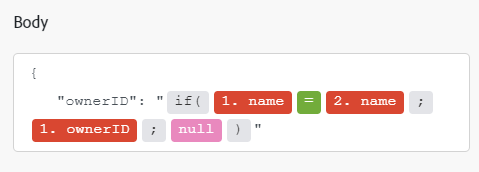JSON modules
The Adobe Workfront Fusion JSON app provides modules to process data in JSON format so that Adobe Workfront Fusion can further work with the data content, or create new JSON content.
Access requirements
| table 0-row-2 1-row-2 2-row-2 layout-auto html-authored no-header | |
|---|---|
| Adobe Workfront package |
Any Adobe Workfront Workflow package and any Adobe Workfront Automation and Integration package Workfront Ultimate Workfront Prime and Select packages, with an additional purchase of Workfront Fusion. |
| Adobe Workfront licenses |
Standard Work or higher |
| Product | If your organization has a Select or Prime Workfront package that does not include Workfront Automation and Integration, your organization must purchase Adobe Workfront Fusion. |
For more detail about the information in this table, see Access requirements in documentation.
Considerations when parsing JSON
Data structure
The Data structure describes how the JSON data is organized and enables the mapping of individual JSON items to other modules in your scenario. If you don’t provide the Data structure, you may manually execute the module and Workfront Fusion will build the structure from the provided JSON:
- Add the Parse JSON module to a scenario.
- In the JSON String field, enter the JSON from which you want to build a data structure.
- Do not connect other modules to the Parse JSON module yet. Because Workfront Fusion does not yet know the structure of the JSON data, it is not yet possible to map data from the Parse JSON module to other modules in your scenario.
- Manually run the scenario. This allows the Parse JSON module to identify the JSON structure from the JSON you have provided.
- You can now connect following modules. The items from the Parse JSON module are now available for mapping.
For more information, see Data structures in Adobe Workfront Fusion.
Collection vs. Array
If the JSON string field contains a collection { ... }, The output is a single bundle containing the items of the collection.
Example:
{
"name" : "Peter",
"ID" : 1>}

If the JSON string field contains an array [ ... ], the output is a series of bundles. each bundle contains one element of the array.
Example:
[
{
"name" : "Peter",
"ID" : 1
},
{
"name" : "Mike",
"ID" : 2
}
]

JSON modules and their fields
When you configure JSON modules, Workfront Fusion displays the fields listed below. Along with these, additional JSON fields might display, depending on factors such as your access level in the app or service. A bolded title in a module indicates a required field.
If you see the map button above a field or function, you can use it to set variables and functions for that field. For more information, see Map information from one module to another.

Aggregators
Aggregate to JSON
This aggregator module aggregates output from a previous module into JSON.
Transformers
Convert JSON to XML
This action module converts a JSON string to XML.
Create JSON
This action module creates JSON from a data structure.
Parse JSON
This action module parses a JSON string into a data structure, which allows you to access the data inside the JSON string.
Transform JSON
This action module transforms an object into a json string.
Transforming data records to JSON
Example: The following example shows how to transform data records from Google Sheets to JSON format:
-
Place the Google Sheets > Select rows module in your scenario to fetch the data. Set up the module to retrieve rows from your Google spreadsheet. Set theMaximum number of returned rows to a small number, but larger than one for testing purposes (Example, three). Execute the Google Sheets module by right-clicking it and choosing “Run this module only.” Verify the output of the module.
-
Connect the Array Aggregator module after the Google Sheets module. In the module’s setup choose the Google Sheets module in the Source node field. Leave the other fields as they are for the moment.
-
Connect JSON > Create JSON module after the Array Aggregator module. The module’s setup requires a Data structure that describes the JSON format. Click Add to open the Data structure setup. The easiest way to create this Data structure is to generate it automatically from a JSON sample. Click Generator and paste your JSON sample to the Sample data field:
Example:
code language-none { "books": [ { "id": "ID", "title": "Title", "author": "Author" } ] } -
Click Save. The Specification field in the Data structure now contains the generated structure.
-
Change the name of your Data structure to something more specific and click Save. A field corresponding to the root array attribute appears as a mappable field in the JSON module’s setup.
-
Click the Map button next to the field and map the
Array[]item from the Array aggregator output to it. -
Click OK to close the JSON module’s setup.
-
Open the setup of the Array Aggregator module. Change the Target structure from Custom to the JSON module’s field corresponding to the root array attribute. Map items from the Google Sheets module to the appropriate fields.
-
Click OK to close the Array Aggregator module’s setup.
-
Run the scenario.
The JSON module outputs the correct JSON format.
-
Open the setup of the Google Sheets module and increase the Maximum number of returned rows number to be larger than the number of rows in your spreadsheet to process all the data.
Troubleshooting
Cannot map data from the Parse JSON module
Make sure that the JSON content is properly mapped into the Parse JSON module and that the data structure is correctly defined. For more information, see Transforming data records to JSON in this article.
Module fails when using conditional statements in JSON
When using conditional statements such as if in your JSON, put the quotation marks outside of the conditional statement.
Example:
